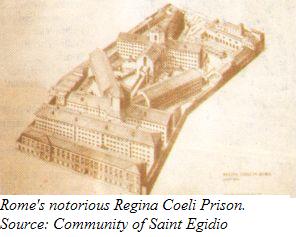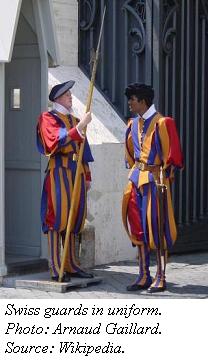Monsignor Hugh O'Flaherty
"God's Traveler."
 The war, from the beginning, created a huge number of homeless, displaced, missing, and imprisoned persons. At the same time, the war prevented the Holy Office from doing its usual business. So it was decided that the Office should handle the refugee issues. One Msgr. Bergoncini Duca was appointed to be the Pope’s messenger to the many prisoner-of-war camps scattered throughout Northern Italy. Tagging along as secretary and interpreter was Hugh O’Flaherty.
The war, from the beginning, created a huge number of homeless, displaced, missing, and imprisoned persons. At the same time, the war prevented the Holy Office from doing its usual business. So it was decided that the Office should handle the refugee issues. One Msgr. Bergoncini Duca was appointed to be the Pope’s messenger to the many prisoner-of-war camps scattered throughout Northern Italy. Tagging along as secretary and interpreter was Hugh O’Flaherty. They started their tour of the camps on Easter, 1941. Msgr. Duca’s style was to set a stately pace, inspecting one camp a day, spending the evenings at hotels. O’Flaherty’s style was to spend hours talking with the prisoners, then, at night, travel back to Rome by a fast train. He would relay messages from the prisoners to his friend Father Owen Sneddon, who worked at the Vatican’s radio station. Sneddon would broadcast the information so the prisoners’ families would know they were alive. Meanwhile O’Flaherty would rush back to join Duca at another camp.
Somewhere O’Flaherty also found the time to arrange for warm clothing to be delivered to the camps in time for the cold Northern Italian winter. He collected and distributed an estimated ten thousand books for the prisoners—and didn’t let official camp censors stand in his way. When bureaucracy held up the delivery of Red Cross packages, O’Flaherty blatantly cut through red tape and regulations until the parcels reached the prisoners. The camps at Modena and Piacenza were very badly run; with a word in the right ear, O’Flaherty managed to get both camps’ commandants fired. A visit from O’Flaherty, the authorities found, would raise the prisoners’ spirits, and lower the morale of the guards.
After half a year of this, J.P. Gallagher writes, “the Italian Government decided it was time this pest was kept out of their POW camps.” Bureaucratic pressure was brought to bear on Vatican officials. By December of 1942, O’Flaherty was instructed to resign his work in the camps. In obedience to his superiors, the monsignor returned to Rome. But not before he had drawn attention on many levels. Michael MacWhite, the Irish envoy to Italy, even mentioned O’Flaherty in one of his dispatches back to Dublin: “It would not surprise me if he found himself in a concentration camp one of these days …”
The First Rescues.
As it turned out, it was a good thing O’Flaherty came back to Rome when he did. Mussolini and the Germans were beginning to crack down on those Roman citizens they felt were dangerous or undesirable. Their targets included prominent Jews, well-known anti-Fascists, and Italian aristocrats who were vocal in their opposition to the regime. O’Flaherty knew many of these people. They were the society he had socialized with before the war. And when they found themselves in danger, it’s not surprising that the first person they thought of turning to was the Irish priest.O’Flaherty began by asking some of his friends who were not under scrutiny to open their homes to those of his friends who were. Then he began sending people to monasteries or convents for refuge. As the Fascist raids became more dangerous, O’Flaherty started bringing people directly into Vatican City.
One of the first of these was Princess Nini Pallavicini, a young widow from one of Rome’s oldest aristocratic families. She had been discovered operating an illegal radio and had only escaped arrest by jumping out a window. O’Flaherty found a room for her in his own place of residence, a building known as the “German College,” because it had traditionally housed German religious scholars, and was staffed by German nuns. O’Flaherty had lived there since the beginning of his Vatican career, and had developed a great admiration for the German people and their culture—he even did his best to learn their language, although he never spoke it as well as he did French and Italian. It is, of course, an enormous irony that thanks to O’Flaherty, the German College would keep many of its country’s “enemies” safe for the duration of the war.
 Another group who knew O’Flaherty and was inclined to come to him for help were the prisoners-of-war who had met the priest during his visits to the camps. Any POWs who managed to escape tended to head for Rome, in search of the British embassy. St. Peter’s Basilica was an inviting destination too; surely the church had to offer shelter to anyone who asked?
Another group who knew O’Flaherty and was inclined to come to him for help were the prisoners-of-war who had met the priest during his visits to the camps. Any POWs who managed to escape tended to head for Rome, in search of the British embassy. St. Peter’s Basilica was an inviting destination too; surely the church had to offer shelter to anyone who asked?
The Vatican was doing what it could. All the diplomats from the countries now considered Italy’s enemies had been moved into the Vatican. Some 477 Jews would be sheltered in the Vatican throughout the war, and other early refugees found sanctuary there as well. But 0.44 square kilometers can only hold so many people, and the Nazis were keeping a close eye on Vatican activity. By the beginning of 1943, the Swiss Guard, the Vatican’s police force, was ordered to turn asylum-seekers away. One such group of British escapees was standing bewildered in the middle of St. Peter’s Square when someone brought them to O’Flaherty’s attention. The Irishman arranged to have them hidden in the barracks of a sympathetic Italian police brigade. It was all in a day’s good work for O’Flaherty. He probably had no idea what he had started.